1st March 2017
An Explore Around the Remote, Beautiful, Rugged East of the Island
The air-conditioning in my room was too fierce; I switched it off. I was aware of a few downpours through the night, and the ever present lyrical croak of the whistling frogs.
I emerged onto the veranda to find Rex casually checking his emails and shares. He had been discussing with friends how it would be possible to wind down my "batteries" to slow me down to a more sedate pace of life. Hmm... when I get to that stage I think I would want to be put down. Pete, his neighbour, commented in true engineering fashion that the heat would probably rejuvenate my "batteries". His engineering friend from Yorkshire commented that his kids used to warm batteries in the gas oven, but suggested that plenty of beer and rum may adjust my electrolyte levels in the right direction. Rex was wondering why most of his friends were engineers.
At the end of the road where we stayed was a patch of rough ground which the builders from the hotel development used for parking their vehicles. Over the course of a couple of hours, they streamed past on their way to work, some stopping off at a car parked at the corner of the road dispensing a breakfast of sorts.
The sun was steadily climbing higher, fluffy white clouds scudded by, constantly driven by the Trade Winds pouring in over the Atlantic from the north-east. The occasional plane skirted by on its way to Grantley Adams International Airport.
After breakfast we headed off towards the eastern coast of the island, choosing the motorway route, which was really a dual carriageway which petered out at the airport.
The roads took a downhill turn after that. We passed through small villages, collections of modern buildings and old wooden shanties, mainly chattels raised up off the ground. The landscape was dotted with chimneys of past and present sugar mills. Fluorescent-orange clad inmates of the island's penitentiary laboured away in fields within their complex. "They would be better employed fixing the roads," quipped Rex. Young sugar cane was growing across the land, together with banana plantations, with stretches of roughly tilled earth between. Gangs of young men sat by mounds of coconuts on road verges, lopping off the tops of the nuts with machetes and serving up the milk to anyone who stopped by. Shortly after the Six Cross Roads junction, we arrived at the Sunbury Plantation House.
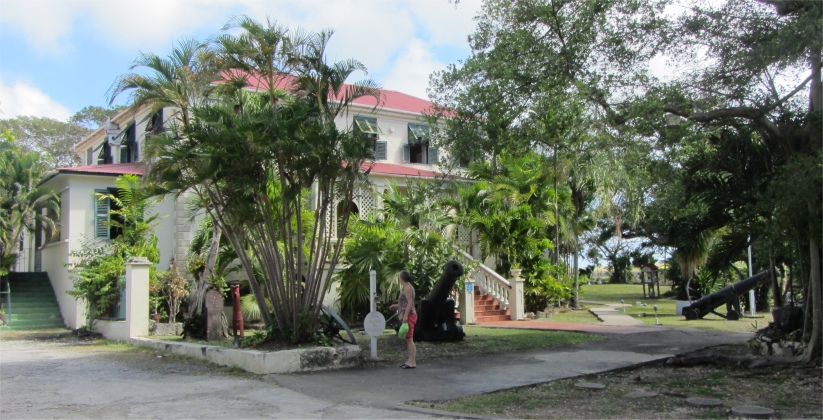
Sunbury Plantation House
|
There was only one other vehicle parked in the car park, so fortunately we would not be surrounded by hordes of other tourists. A woman popped out of the front door and asked us to wander around the gardens for 10 minutes or so before she started her tour. On entering the house, she disappeared off for another 10 minutes to find change. But eventually she reappeared and started to give us and two British ladies a short tour of the house.
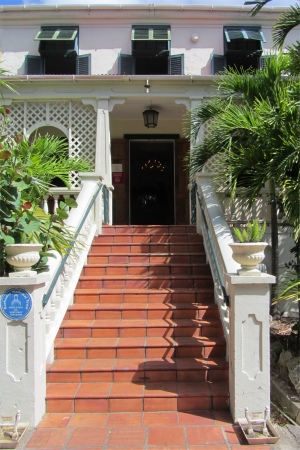
Grand Entrance to Sunbury Plantation House
|
The history of Sunbury Plantation House goes back over three hundred years. It was built around 1660 by Matthew Chapman, an Irish/English planter, one of the first settlers on the island. He was related to the Earl of Carlisle and through this association, was granted lands in Barbados. The name Chapman appears in the first map of the island in 1638. Thomas was married to Mary Clegett. They had three children, John, Matthew and Richard, all owning lands in St. Philip. Matthew and his wife Isobella had eight children, two of whom married into Quaker families. The Quakers owned much land in the parish of St. Philip.

Impeccable Interior
|
The 1674 map shows Chapman Plantation operating with a Cattle Mill. Matthew purchased neighbouring lands and thus enlarged his Plantation. After his death in 1693 the Plantation was sold to Nathaniel Branker who married Ann Carter. The Carters had small land holdings near to the Plantation, and to this day some fields at Sunbury are still named Carters.
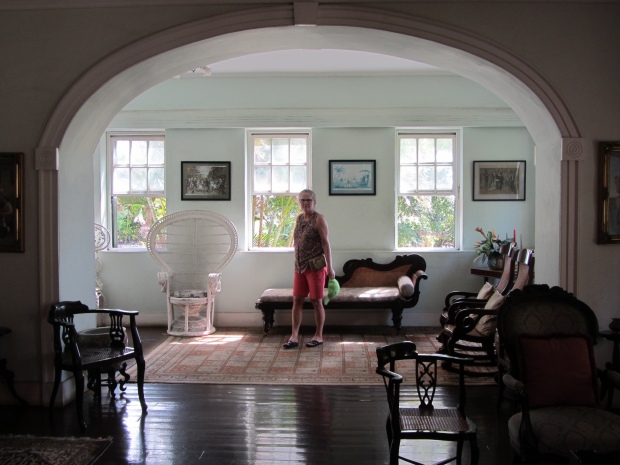
Meryl About to Take a Nap
|
Chapman's Plantation was re-named Brankers after its second owner until 1763 when it was sold to James Butler Harris and his wife Elizabeth. Elizabeth was the granddaughter of Matthew Chapman. It was during Harris's ownership that the bell in the Bell House was erected. To this day it stands with the name " James Butler Harris 1766 ".
After the death of Mr. Harris 14 years later the estate was purchased by great family friends, John and George Barrow. The Barrow family lived at Sunbury from 1775 until 1835. For the first few years the Plantation was nicknamed Brothers but it was soon renamed Sunbury after their home in Kent. John Henry Barrow married Francis Mayers of nearby Halton Plantation in 1764. In 1777, the diaries of William Senhouse describe Sunbury as having a garden resembling that of St. Michael's Cathedral in layout. To this day some of the black willow trees date back to this era. Senhouse also describes Sunbury as "one of the best built plantation houses on the island". John Henry Barrow planted the first teak tree at Sunbury in 1799. He also planted a grove of 300 mahogany trees, the first to be introduced to the island. Over one third of these trees remain today.
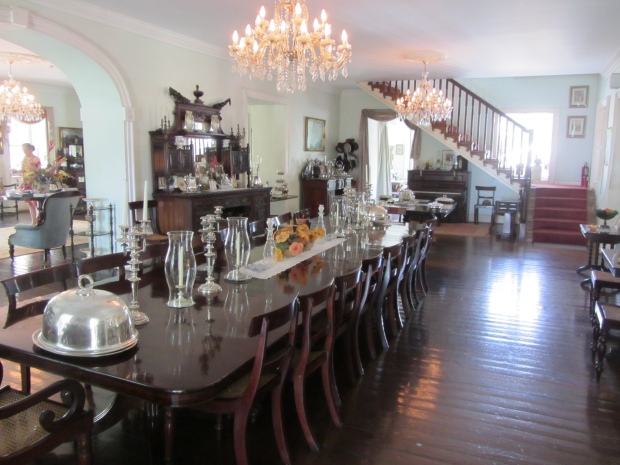
200-year Old Table. Why not Join the Banquet at over BDS150$ a Head
|
The son of John Henry Barrow married Mary Ward Senhouse. He inherited the Plantation and was Colonel in charge of the slave rebellion in 1816. Sunbury sustained almost £4,000 in damage from the rebellion. The leader of the slave rebellion at Sunbury was King William, a friend of Bussa the rebellion leader who was later tried and put to death for his crime.
In 1835 the Hon. John Barrow emigrated to New Foundland. The brothers Thomas and John Daniel bought the estate out of the Court of Chancery for the sum of £33,000. The estate then comprised of 413 acres and there were 224 slave apprentices after the abolition of slavery.
The Daniels were absentee proprietors who owned many plantations on the island as well as a fleet of ships for transporting their sugar. Thomas Daniel was a great friend of the notorious Sam Lord of Sam Lord's Castle. Sam Lord spent many an evening at dining at Sunbury and when Lucy, Sam Lord's wife, fled the island and returned to England it was probably in one of Thomas Daniel's ships. Thomas would also transport alimony for Lucy and her child from Sam.

Sleep off the Banquet
|
In 1896, a Scotsman, Alistair Cameron, came to the island to work in shipping with Mr. Daniel. Alistair purchased the estate and married Daniel's niece, Laura Sussanah Roope. Alistair and Laura had five children, four daughters and one son. Their son died at an early age in the 1930's. There were no offspring of the Cameron girls, two of them remaining spinsters until their deaths in 1980 and 1981. The main Sunbury House was divided from the estate and sold to Mr. and Mrs. Keith Melville. The rest was sold to Mr. Geoffrey Armstrong. The Melvilles, both keen horse lovers, started their horse drawn collection many years ago. What began as a hobby grew into a most comprehensive collection of antiques and artefacts of a bygone era, many old carts and machinery still visible in the open barns by the house. The Melville's resided at Sunbury until 1985, the house being opened to the public in January 1984.
The main building features quoined corner. A water catchment situated on the west side of the house is dated 1788 suggesting that this was the date that the roof was replaced following damage in the 1780 hurricanes. The house suffered a disastrous fire on July 24th 1995. The furniture that was destroyed by the fire was replaced by part of the Harold Bowen collection as well as with many items made available for purchase by numerous Bajan families.
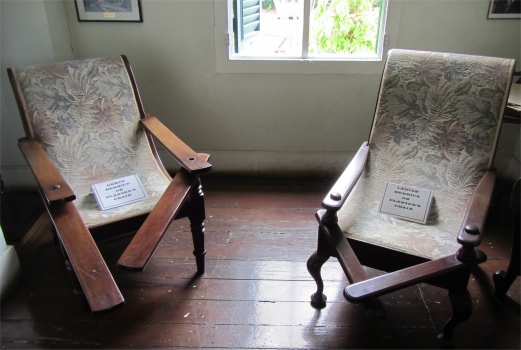
Berbice or Planters Chairs - Man's on left, Woman's on Right. Foldable Slats are for Legs
|
A survivor of innumerable hurricanes, Sunbury boasts walls of approximately 75cm thick. Its sash windows are protected by jalousies on the outside and storm shutters on the inside. In the event of a hurricane, the whole house can be quickly closed up.
As we were shown around the main living room of the house, our guide was not exactly gushing with information, but she fielded all our questions with an easy smile and a touch of humour. Mr. and Mrs. Melville had exercised impeccable taste in their choice of fixtures and furnishings with the result that Sunbury House now possessed one of the country's superior collections of antiques. We were left to show ourselves around some of the storage areas of the house. The cellars, originally used for storing yams and other root vegetables grown on the plantation, now house a unique collection of antique carriages, the largest collection in the Caribbean, as well as many items used in the domestic life of the plantation. It also houses the very old collection of optical machinery and sight testing equipment, some of the first to come to the West Indies. This included the first lens grinding plant bought by the late Dr. Harcourt Carter, Mr. Melville's grandfather.
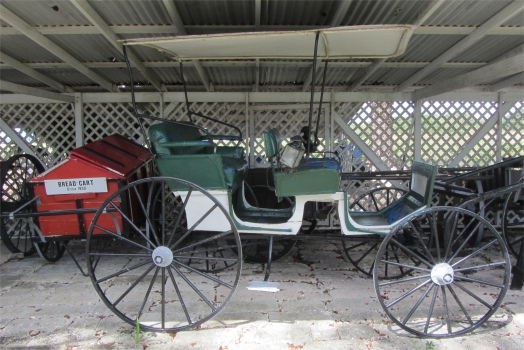
Antique Carriage
|
Outside the house, around the corner, a large table had been set up with a large array of rums stacked. Some large groups were obviously expected, perhaps off a cruise ship. A good time to move on we thought.
We headed in a sort of north east direction. I say sort of because the roads seemed to traverse the land in haphazard directions. We passed close to a district known as Whitehaven. This immediately rang a bell with me; I was born at Whitehaven in Cumbria. Curiosity reared its head, a little diversion is in order.
During the 18th and early 19th centuries, African slaves were central to the production of sugar, tobacco and other tropical crops on British plantations in the West Indies and mainland North America. Accordingly, the triangular slave trade, comprising the export of textiles and other manufactures from Britain to Africa for the purchasing of slaves, the slaves' transportation to the Americas (the "Middle Passage") and finally their exchange for slave-produced goods for sale back home. This became a significant feature of Britain's overseas commerce during this period.
In the course of the 18th century, the northern ports of Lancaster and Whitehaven's slave ships would have carried in excess of 29,000 and 14,000 slaves, respectively, out of Africa. Though overshadowed by Liverpool, London and Bristol, these statistics put them at the forefront of smaller operators. Both ports were most actively involved between 1750 - 1775. Whitehaven ships accounted for nearly 60 slaving voyages. Interestingly, the slave trade started earlier at Whitehaven, the Swift sailing to Africa in 1711.
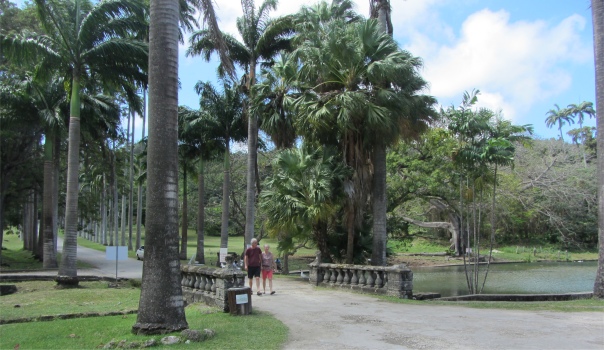
Grounds of Codrington Theological College
|
Whitehaven ships were typically directed south to the Gold and Bonny coasts where larger consignments of slaves were generally on offer, and most confined their sales to the established slave markets of Jamaica and Barbados.
The cornerstone of Whitehaven's colonial trade was with the tobacco planters of Virginia and Maryland, making it one of the leading tobacco ports between 1700 - 1750, but its merchants also developed a trade with the West Indies. Vessels would take on goods in Ireland to help compensate for geographical isolation.
Whitehaven had its successful rum merchants the Jeffersons. Ownership of plantation slaves can just as readily be associated with those living in and around Whitehaven. Prominent amongst them were the Lowther and Senhouse families who bought plantations in Barbados and the Jefferson family whose rum supplies were enhanced through purchasing a plantation in Antigua. Many would receive compensation after slavery's abolition in the British Caribbean between 1834 and 1838. Wealth and trade translated into fine town houses and substantial warehouses in the port.
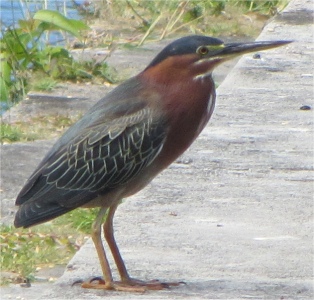
Guallin Green Heron
|
Whitehaven quit the trade in 1769. It may be that Whitehaven's earlier withdrawal from the trade ultimately reflected disappointing returns, especially from the perspective of more established merchants who also faced mounting competition from Liverpool in their preferred African and West Indian destinations.
Not much further north, and we passed by a large expanse of lawn to our right, with an impressive stand of royal palms lining the road leading down to the coral-stoned buildings and serene grounds of Codrington Theological College.
Christopher Codrington III (1668-1710), the benefactor after whom Codrington Theological College is named, was the son of a very prominent Bajan, Christopher Codrington II, who was at one time Governor General of the Leeward Islands. He was born either at Codrington Plantation in St. Michael, or Didmarton Plantation, now called Society, in St. John. He spent most of his boyhood at Consetts, the site of the present College. After joining his father in Antigua for a short while, Christopher Codrington III went to England where he took a degree at Oxford University and became a Fellow of All Souls College. He served in the Army for some time before returning to the Leeward Islands to succeed his father as Governor General. His policy of amelioration of the poor whites and slaves brought him into disfavour of the plantocracy. Consequently, he gave up the position of Governor Codrington College and returned to Barbados to live in retirement at Consetts in St. John.
|
|
Codrington Theological College (please use scroll bar)
|
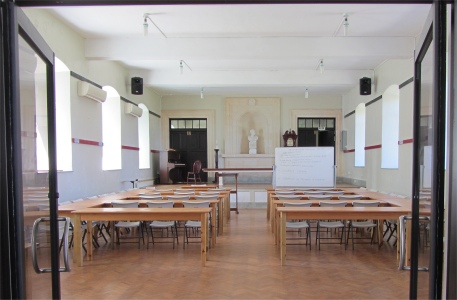
College Classroom
|
Christopher Codrington III, died on Good Friday, April 7, 1710 and was buried at St. Michael's Cathedral. Later his body was exhumed and taken to be buried in the Chapel of All Saints College, to which he bequeathed his large selection of books and £10,000 in cash. In his will he had left to the Society for the Propagation of the Gospel (SPG) the estates at Society and Consetts. One of the purposes of the bequest was that there should be maintained a number of professors who should be obliged to teach medicine, surgery and divinity. So his request stated:
"Give and Bequeath my two Plantations in the Island of Barbados to the Society for propagation of the Christian Religion in Forreighn parts, Erected and Established by my Late good master, King William the Third, and my desire is to have the Plantations Continued Intire and three hundred negros at Least Kept always thereon, and A Convenient number of Professors and Scholars Maintained there, all of them to be under the vows of Chastity and obedience, who shall be oblidged to Studdy and Practice Physick and Chyrurgery as well as divinity, that by the apparent usefulness of the former to all mankind, they may Both indear themselves to the People and have better oppertunitys of doeing good To mens Souls whilst Takeing Care of their Bodys."
For some time the estates were ran by Bajan planters, who acted either as agents or trustees or managers, conducting business in the way all estates in Barbados were ran. Codrington's desire to Christianise the slaves was rejected by the Bajan plantocracy, who opposed teaching the slaves how to read and write. Evidence shows that the slaves were even branded with the letters "SOCIETY" on their chest, a practice that was discontinued when Reverend Holt, Rector of St. Andrew protested to the SPG. In 1741 over 100 slaves from the estates marched to Bridgetown to protest their treatment to the SPG's agent in Barbados. It was only in 1790 when the anti-slavery movement in England exerted pressure on the Anglican Church and the SPG that there was some amelioration in the conditions of the slaves.
|
|
Looking East from the Back of Codrington Theological College (please use scroll bar)
|
After some delay, the result of legal disputes, the erection of the College got under way in 1715. The buildings were not completed until 1743, economic depression, drought and other difficulties having caused further delays. The College was officially opened on 9th September 1745 and the Chapel dedicated on 11th June 1749, the Feast of St. Barnabas. In 1745 a grammar school, The Lodge School, was established at the Chaplain's Lodge (thus the name) to teach the basics of education, reading, writing, Latin, and accountancy.
For a long time the College provided a general education which included philosophy and divinity. As early as 1748 it began lectures in advanced studies, following the appointment of professors of Philosophy and Mathematics, and of surgery, though Codrington College never produced medical doctors or surgeons. The first graduate was ordained as early as 1759. In this regard, it catered for the sons of the local gentry who would otherwise have gone to England for their education. It also catered for a number of poorer, but academically able, young boys. It served, therefore to prepare young Bajans for entry into the two Universities in England: Oxford and Cambridge. Later on the College began to offer tertiary education, and was affiliated to the University of Durham in 1875. It prepared candidates for Durham degrees until 1958. At a later date the College became affiliated to the University of the West Indies, for whose degree and Licentiate candidates are now examined.

Conset Bay Far Below
|
It was in 1830 that the College began training candidates exclusively for ordination under the Rev. J.H. Pinder. Codrington College, therefore, holds a venerable place in the Anglican Communion as its first Theological College. It ante-dated Chichester (1839) England's First, and Wells (1840), in which latter, J.H. Pinder became the first Principal. He had served at Codrington from 1829-35. An eminent successor of Pinder's, Richard Rawle, 1847 - 1864, successfully opposed the attempt to have the College revert to its former function of educating the sons of the gentry.
Following affiliation with the University of Durham in 1875, the College proceeded to offer programmes in Classics as well as in Theology. As a result, the College has produced many persons who made their mark in teaching, law, medicine, the civil service, as well as in the Church. Since 1955, following the establishment of the University of the West Indies, the College has concentrated on Theological Studies. Its graduates are to be found in various parts of the Anglican Communion: Europe, Africa, North America, Australia, as well as the West Indies. A new development followed the affiliation of the College to the University of the West Indies in 1965. By virtue of this arrangement, the students of the College may be admitted to the Licentiate in Theology and the B.A. Theology of the University. Though the affiliation with Durham University continues, and students may still enter for the Durham B.A. Hons. In Theology, this affiliation is being used for post-graduate studies.
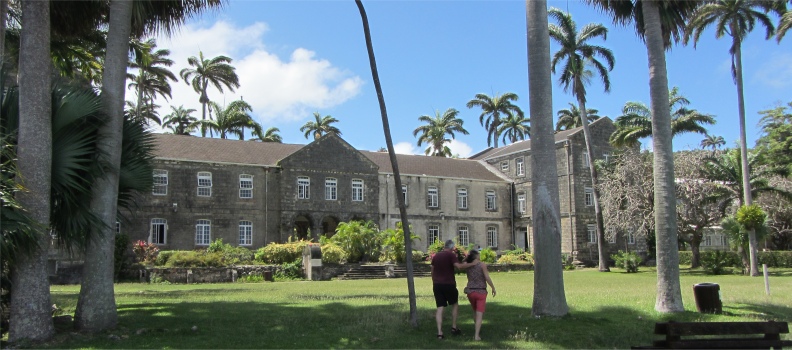
Time to Walk Back Through the College
|
We parked up and wandered around the grounds at our leisure; the buildings were not open to the public. A large pond full of fish mirrored the northern end of the magnificent building, guarded by a bevy of strutting ducks and a single Guallin Green Heron, who must have thought he was in paradise watching all the fish swimming below him. The ducks were more interested in mating.
Open arched passageways in the centre of the building allowed us to walk through to the other side. Here a large stretch of manicured lawn suddenly dropped from view, inviting me to walk over and see what was on the other side. It soon became apparent that the college was built on the crest of a cliff, probably to catch the best of the constant breeze. The ground spectacularly tumbled all the way down to Windy Ridge before dropping to Conset Bay and the Atlantic beyond. Far below, the Atlantic breakers were surging over coral reefs before crashing onto rocky shores. The rugged beauty of this coastline stretches far away, punctuated by cliffs. Most of the length of the eastern coastline of the island contains lush, craggy foothills soaring to high cliffs overlooking the ocean. It is a remote area, populated by the odd small villages. Because of the Atlantic swell rolling in continuously, it is a coastline popular with serious surfers. However, it is a dangerous place to swim; many of those who try wash up on western African shores months later.
The bonus we had here was the fact that there was only a handful of other people here. What a beautiful, tranquil setting it was, a place where you could lose yourself to your thoughts for hours on end.

St. John's Parish Church
|
Another bone jarring lurch over lunar landscape roads brought us to the delightful setting of St. John's Parish Church. Set on a cliff-edge site that has been described as the most romantic location on the island of Barbados, St. John's Parish Church commands sweeping views that stretch from Ragged Point in the east to Pico Tenerife in the north.
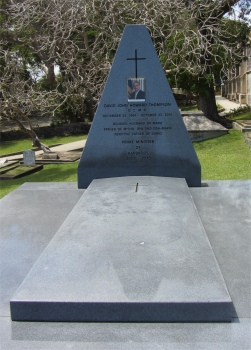
Grave of David John Howard Thompson
Prime Minister of Barbados 2008-10
|
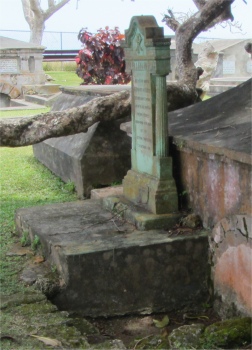
Grave of Ferdinando Paleologus
|
The church lies on the site of the first wooden church constructed in 1645, making it one of the oldest churches in Barbados. The wooden building was destroyed by fire and was replaced in 1660 when construction on a stone structure began. This church building was to cost the diocese 110,000 lbs of sugar.
In the hurricane that struck the island of Barbados in 1675, this new church was badly damaged and was completely torn down by 1676. With true Christian perseverance however, another church was built but this structure too fell victim to yet another hurricane in the year 1780. This destruction was again to be the fate of the St. John's Parish Church in Barbados in 1831 when the church was completely destroyed by that great hurricane. The church as we see it today was completed in 1836 and was rededicated on 23rd June the same year. Its pure Gothic design was influenced by Bishop William Hart Coleridge, first Anglican Bishop. Its chancel was a later addition some forty years after construction with its beautiful stained glass windows being added quite a bit later in 1907.
This beautiful Gothic inspired church is quite a popular attraction for both locals and tourists to the island. The rich history of this church includes a connection to Constantinople, now Istanbul, since it is the final resting place of Ferdinando Paleologus, a descendant of Emperor Constantine the Great, whose family was driven from the throne in Constantinople by the Turks. Ferdinando died here in 1678, after being a resident for over 20 years. His tomb is marked by a granite tombstone in the rear of church's cemetery.
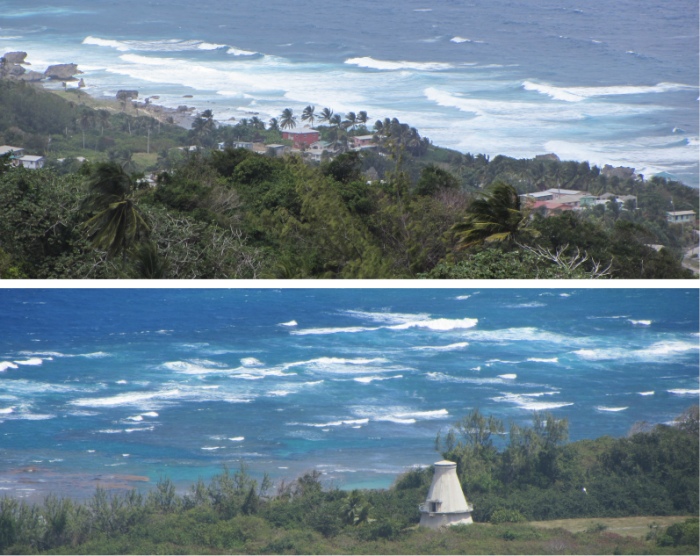
Turbulent Coastline Below
|
Ferdinand was very active in his adopted home of Barbados. In addition to being a planter in the parish on his plantation called Clifton Hall, he was also a warden at the parish church. Even in death he managed to move around. After the hurricane of 1831, Paleologus' body was found embedded in quicklime with his head facing west (in accordance with Eastern orthodox custom) under the organ loft in the vault of Sir Peter Colleton, the deputy Governor of Barbados (1673). The body was then moved and reinterred at its present location in the church's graveyard.
Other graves of note in the serene churchyard are the grave of Thomas Hughes directly behind that of Paleologus, who was buried in a standing position at his own request since he rarely sat in the job which he held, and that of David John Howard Thompson, Prime Minister of Barbados 2008-10, who died at the young age of 48.
Of special interest at this church is the elaborately carved pulpit which is said to contain six different woods; ebony, locust, Barbados mahogany, manchineel, oak and pine, the first four of which are indigenous to Barbados. Additionally the church is also known for its beautifully designed curved staircases which flank either side of the entrance and the Westmacott sculpture which adorns the wall to the left of the church's main door which stands in tribute to Elizabeth Pinder. I would not say the interior of the church was elaborate, but its simple stonework and mahogany covered ceilings created a real depth of charm. St. John's Parish Church is also the location of one of only two intact sundials in Barbados, the other located at Codrington Theological College, which Rex had checked a short while earlier and found it to be totally accurate.
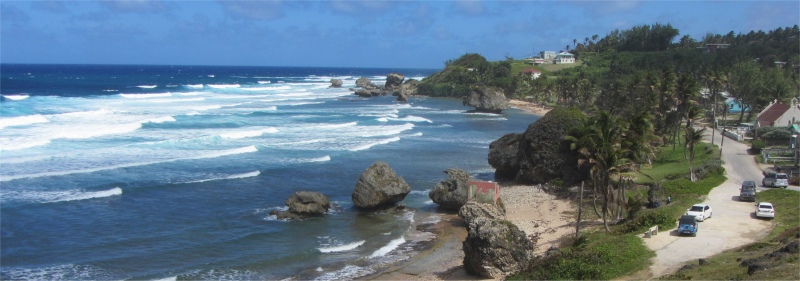
Bathsheba
|
Having spent a while up on the dizzy heights along this section of the eastern coast, it was time to drop down to the coast. We twisted our way down through lush, leafy groves to the coastal road. This road snaking along the coast was unbelievable. At times it was as if the raw earth had just been coated in a couple of inches of asphalt, and left to bear the ravages of traffic and time, cracking up and dissolving into potholes. Being a remote area with little usage, perhaps the planners just leave it that way.
Mongeese, introduced to control the rat population, occasionally dashed across the road, looking as if an unravelling old piece of rope was being tugged across by an invisible thread. Unfortunately, mongeese are diurnal animals, rats are mainly nocturnal. We stopped off at a set of stables in order for Meryl to book herself in for a hack the following Monday.
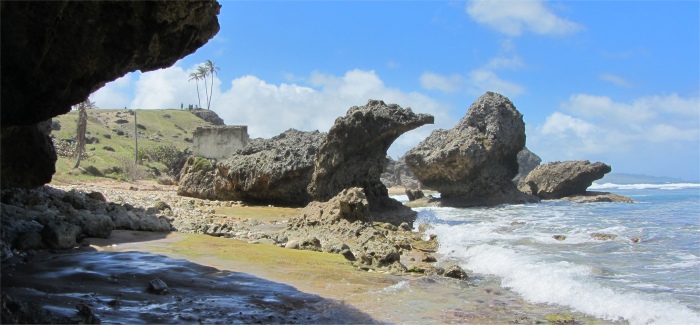
Fabulous Coral Rock Formations
|
We bounced our way along to Bathsheba, passing through a most spectacular seascape with the huge Atlantic waves breaking over rocks and reefs to form small pools close to shore to our right, and the scene being completed by the presence of looming hills and mountains inland. Poor Meryl was complaining that it was a back-breaking exercise in the back of the car. There is no real venue in Bathsheba as such, just a straddle of buildings on both sides of the coastal road, home to a small community of fishing folk and their families, along with guest houses, local rum shops and restaurants. The real gem here is the stretch of coastline.
The Atlantic rollers were breaking on the large rocks at sea to form beautiful mist and foam. Legend has it that Bathsheba, wife of King David, bathed in milk to keep her skin beautiful and soft. Legend also says that the surf covered white waters of Bathsheba, rich in minerals and life, is said to resemble Bathsheba's bath in both appearance and health giving value. A little poetic licence there perhaps.
It is breathtakingly beautiful; wide white sand beaches stretch along a dramatic coastline of striking rock formations against which the Atlantic rollers break in cascades of foam. What at first glance look like huge boulders washed up on the beach are actually rock formations broken away from ancient coral reef.
The pools along this stretch of coast are carved out of the inshore coral reef and are a few feet away from the sandy shore. They are several feet deep and folk can sit in them enjoying a drink while the surf splashes in, swirling the water around in nature's own whirlpool. Rip tides and undertows await the foolhardy who venture outside the pools. Locals and visitors come to breath the air, soak in the invigorating Bathsheba Pools and feel alive.
We sat on a grassy knoll overlooking the surf sweeping in and enjoyed a picnic. I took advantage of the location and had a paddle on the sand between the large mushroom rocks. The swirling, clear waters around my feet felt delicious. The sunlight playing across the surf created a myriad hues of blue, it really is an enchanting location.
|
|
Bathsheba Beach, Trade Winds Bending the Palms (please use scroll bar)
|
The roads around Bathsheba were more suited to horse and carts. As we attempted to leave, buses trying to pass each other created a jam, which only the Bajans seem to be able to unravel over Bajan timescales.
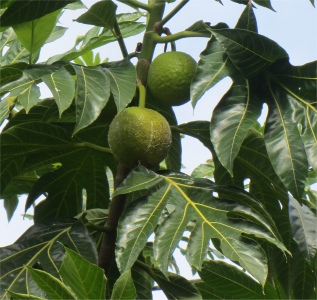
Breadfruit Tree
|
Our final port of call, quite close to Bathsheba, was the Andromeda Botanic Gardens. A charming lady greeted us and gave us a complete run-down on the history of the gardens, the new layout, and she even answered my question on how to prepare breadfruit.
The gardens were established by the renowned multi-award winning Iris Bannochie (1914-1988) as a private family garden on land that had been in her family since 1740. Previously farmland, Mrs Bannochie created a unique garden from scratch with many trees, palms and other plants collected from her travels across the globe. Andromeda Gardens was established by Iris and her husband at the time, Dr Harry Bayley, around her home in St Joseph.
This garden contains an unparalleled collection of different plants from many other tropical and sub-tropical locations, either collected by Iris herself, or given to her as gifts. Mrs Bannochie was the foremost horticulturalist in Barbados and, in 1977, was awarded the prestigious Veitch Medal by the Royal Horticultural Society, United Kingdom. Winner of multiple gold medals at the famous Chelsea Flower Show, Ms Bannochie was also the recipient of the Silver Crown of Merit awarded by the Barbadian Government. She bequeathed Andromeda Gardens to the Barbados National Trust in 1988 so that her legacy could live on and be enjoyed by visitors from within Barbados and around the globe. Despite all these credentials, she is mostly remembered by locals for her eccentricities (and liking for a drink).
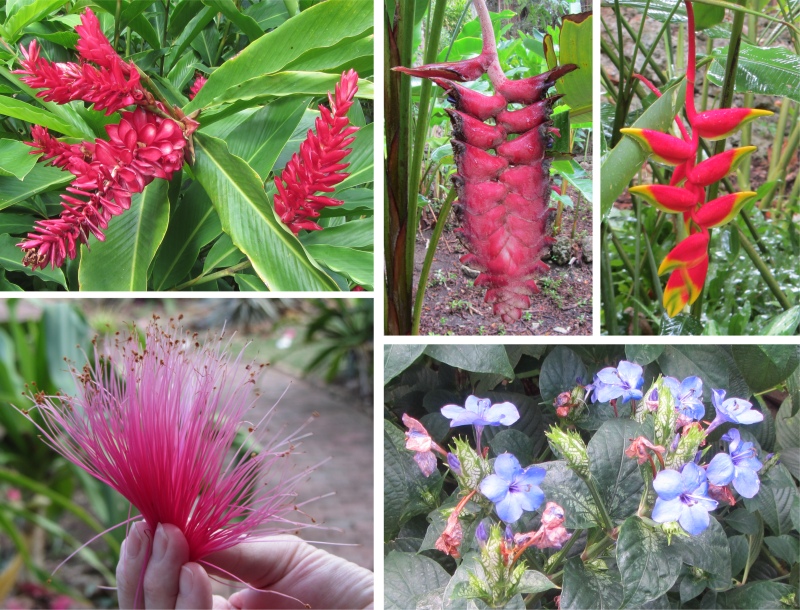
Andromeda Gardens Plants
|
The site littered with huge coral boulders resting on coral stone rock is named after the Greek legend of Andromeda, a maiden who was chained to a rock. The gardens are tethered like the Goddess to the rock.
Amply loaded up with background material, we opted to take the long tour (great for healthy seniors) around the gardens and set forth with our knotted hankies on our heads. The tour map was easy to follow and provided adequate, interesting details. Strangely, as with all the other sites we had visited today, there were not many people about, which suited us. Our exploratory path wound its way through six acres of a wide collection of tropical plants, including orchids, ferns, water lilies, hibiscus, heliconia, bougainvillea, cacti and palms.

Andromeda Gardens Trees, Rex Standing under a Bearded Fig Tree. The Old Portuguese Word for "Bearded Ones" is Los Barbados
|
We took time to chill out by the pond and watch the dragonflies, and sheltered under the jade vine during a heavy downpour talking to one of the handymen. The variety of plants in this historic garden is unparalleled and simply wonderful - a true horticultural delight. More than 1,200 species are represented in the garden; about 75% of them, including 90% of the palms, were introduced to Barbados by Mrs Bannochie.
After asking the lady at the entrance about the preparation of breadfruit, lo and behold we came across a breadfruit tree. This humble food source has had a chequered history. The late-18th-century quest for cheap, high-energy food sources for slaves in British colonies prompted colonial administrators and plantation owners to call for the plant to be brought to the Caribbean. In 1787, William Bligh was appointed Captain of the HMS Bounty, and ordered to proceed to the South Pacific to collect the plants. In 1791, Bligh commanded a second expedition with the Providence and the Assistant, which collected seedless breadfruit plants in Tahiti and transported these to St. Helena in the Atlantic, and St. Vincent and Jamaica in the West Indies. Although Bligh won the Royal Society medal for his efforts, the introduction was not entirely successful, as most slaves refused to eat the new food. Even the best laid plans.
Everywhere a climber (Petrea volubilis), a genus of evergreen flowering vines native to Mexico and Central America, scrambles about with flowers in purple or white. It is known locally as sandpaper plant because the rough leaves were once used to smooth furniture. It looks somewhat similar to a tropical Wisteria. Carl Linnaeus named Petrea in honour of Robert James Petre, 8th Baron Petre of Ingatestone Hall in Essex. Petre was a patron of botany.
We ended our explore with a refreshing drink of lime and ginger, and chatted again with the lady who originally greeted us. "How many people look after the gardens," we asked.
"Just the lady who owns the gardens, and myself run the whole show. Occasionally, when funds permit, we hire in extra help," she replied. Gulp, these were large gardens for two women to look after, but they were doing a splendid job of it.
We returned back to Appelton to attend to essential chores: washing of clothes, drinking tea, Rex playing games on his iPad, and general watching the world go by. Meryl prepared a delicious meal for us all, tuna steak for me and her, plus lamb shoulder for Rex. Superb, all washed down with a beer or two on the veranda as we watched all the "girls" turn up for work at the night club further down our street. None of us knew what sort of night club it was, but the low beat drummed out every night from 10pm till 4am.
Rather late in the evening the trash cart turned up, and thankfully removed the rotting contents from the stinking bins surrounding us. They were constantly being raided by neighbourhood cats day and night.
I smiled in the night as I heard heavy downpours give my washing on the line yet another rinse. They would be dry by morning.
|
Last updated 19.4.2017
|

























